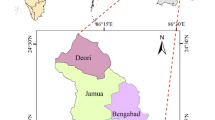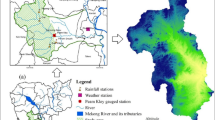Abstract
The assessment of land use land cover (LULC) and climate change over the hydrology of a catchment has become inevitable and is an essential aspect to understand the water resources-related problems within the catchment. For large catchments, mesoscale models such as variable infiltration capacity (VIC) model are required for appropriate hydrological assessment. In this study, Ashti Catchment (sub-catchment of Godavari Basin in India) is considered as a case study to evaluate the impacts of LULC changes and rainfall trends on the hydrological variables using VIC model. The land cover data and rainfall trends for 40 years (1971–2010) were used as driving input parameters to simulate the hydrological changes over the Ashti Catchment and the results are compared with observed runoff. The good agreement between observed and simulated streamflows emphasises that the VIC model is able to evaluate the hydrological changes within the major catchment, satisfactorily. Further, the study shows that evapotranspiration is predominantly governed by the vegetation classes. Evapotranspiration is higher for the forest cover as compared to the evapotranspiration for shrubland/grassland, as the trees with deeper roots draws the soil moisture from the deeper soil layers. The results show that the spatial extent of change in rainfall trends is small as compared to the total catchment. The hydrological response of the catchment shows that small changes in monsoon rainfall predominantly contribute to runoff, which results in higher changes in runoff as the potential evapotranspiration within the catchments is achieved. The study also emphasises that the hydrological implications of climate change are not very significant on the Ashti Catchment, during the last 40 years (1971–2010).








Similar content being viewed by others
References
Burns D H 2008 Climatic influences on streamflow timing in the headwaters of the Mackenzie River Basin; J. Hydrol. 352 (1–2) 225–238.
Chen H, Guo S, Xu C Y and Singh V P 2007 Historical temporal trends of hydro-climatic variables and runoff response to climate variability and their relevance in water resource management in the Hanjiang basin ; J. Hydrol. 344 (3–4) 171–184.
Cherkauer K A and Lettenmaier D P 1999 Hydrologic effects of frozen soils in the upper Mississippi River basin ; J. Geophys. Res. 104 19,599–19,610.
FAO 2003 The digitized soil map of the world and derived soil properties (version 3.5); FAO Land and Water Digital Media Series 1, FAO, Rome.
Hurkmans R, Moel H, Aerts J C J H and Troch P A 2008 Water balance versus land surface model in the simulation of Rhine river discharges; Water Resour. Res. 44 (1) 1–14.
Kalnay E, Kanamitsu M and Kistler R 1996 The NCEP/NCAR 40-years reanalysis project; Bull. Am. Meteorol. Soc. 77 (3) 437–471.
Liang X, Lettenmaier D P, Wood E F and Burges S J 1994 A simple hydrologically based model of land surface water and energy fluxes for general circulation models ; J. Geophys. Res. 99 14,415–14,428.
Liang X, Lettenmaier D P and Wood E F 1996 One-dimensional statistical dynamic representation of sub-grid variability of precipitation in the two-layer variable infiltration capacity model; J. Geophys. Res. 101 403–421.
Lin K, Guo S, Zhang S W and Liu P 2007 A new base flow separation method based on analytical solutions of the Horton infiltration capacity curve; Hydrol. Process. 21 (13) 1719–1736.
Lin K, Zhang Q and Chen X 2010 An evaluation of impacts of DEM resolution and parameter correlation on TOPMODEL modelling uncertainty; J. Hydrol. 394 (3–4) 370–383.
Lohmann D, Nolte-Holube R and Raschke E 1996 A large scale horizontal routing model to be coupled to land surface parameterization schemes; Tellus A 48 (5) 708–721.
Lohmann D R, Raschke E, Nijssen B and Lettenmaier D P 1998 Regional scale hydrology: I. Formulation of the VIC-2L model coupled to a routing model; Hydrol. Sci. J. 43 131–141.
Maurer E P, Wood A W, Adam J C, Lettenmaier D P and Nijssen B 2002 A long-term hydrologically-based dataset of land surface fluxes and states for the conterminous United States; J. Climate 15 3237–3251.
Nijssen B, Greg O’Donnell M and Lettenmaier D P 2000 Predicting the discharge of global rivers; J. Climate 14 (15) 3307–3323.
Nijssen B, Greg O’Donnell M, Hamlet A F and Lettenmaier D P 2001 Hydrologic sensitivity of global rivers to climate change; Climatic Change 50 143–175.
Qiao L, Hong Y, Renee M R, Mark S, David G D, David W D, Chen S and Lilly D 2014 Climate change and hydrological response in the trans-state Oologah Lake watershed–Evaluating dynamically downscaled NARCCAP and statistically downscaled CMIP3 simulations with VIC model BCSD; Water Resour. Manag. 28 3291–3305.
Rajeevan M, Bhate J, Kale J D and Lal B 2005 Development of a high resolution daily gridded rainfall data for the Indian region: Analysis of break and active monsoon spells; Technical Report, India Meteorological Department.
Todini E 1996 The ARNO rainfall-runoff model; J. Hydrol. 175 339–382.
Zhang L, Dawes W R and Walker G R 2001 Response of mean annual evapotranspiration to vegetation changes at catchment scale; Water Resour. Res. 37 (3) 701–708.
Acknowledgements
The authors sincerely acknowledge Central Water Commission (CWC) for providing streamflow data at the Ashti runoff gauging station. The first author is thankful to Prof. Subimal Ghosh for his suggestions, help and valuable guidance.
Author information
Authors and Affiliations
Corresponding author
Additional information
Corresponding editor: Rajib Maity
Rights and permissions
About this article
Cite this article
HENGADE, N., ELDHO, T.I. Assessment of LULC and climate change on the hydrology of Ashti Catchment, India using VIC model. J Earth Syst Sci 125, 1623–1634 (2016). https://doi.org/10.1007/s12040-016-0753-3
Received:
Revised:
Accepted:
Published:
Issue Date:
DOI: https://doi.org/10.1007/s12040-016-0753-3




